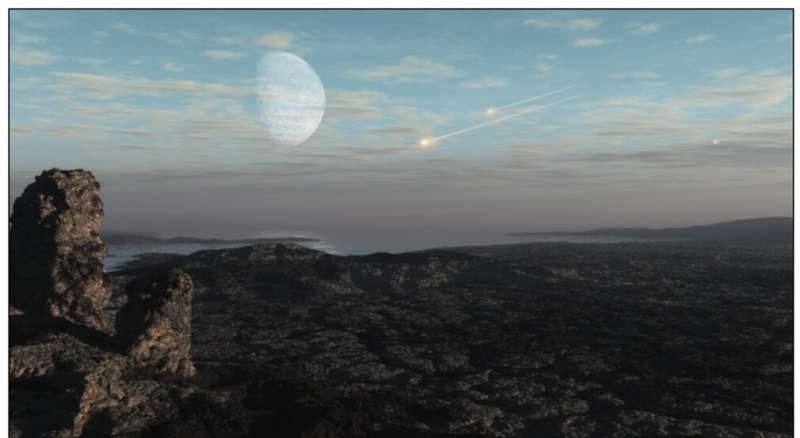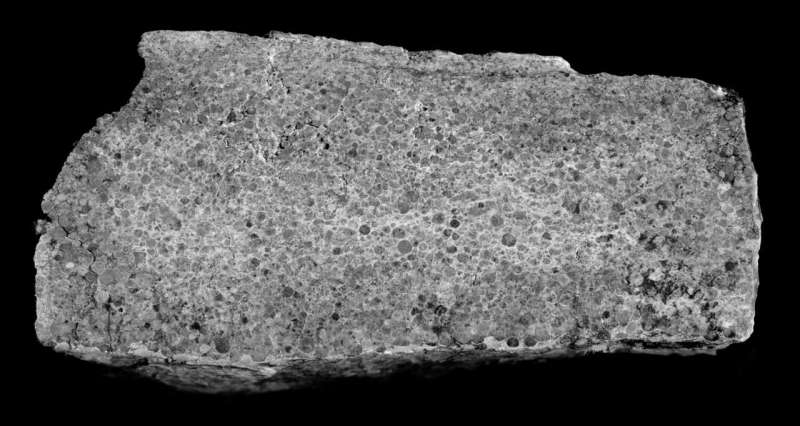A Southwest Research Institute-led team updated planetary bombardment models with the latest geologic information and then applied those models to understand how impacts may have affected oxygen levels in the Earth’s atmosphere in the Archean eon, 2.5 to 4 billion years ago. This artistic conception illustrates large asteroids penetrating Earth’s oxygen-poor atmosphere. Credit: SwRI/Dan Durda, Simone Marchi
Between 2.5 and 4 billion years ago, a time known as the Archean eon, Earth's weather could often be described as cloudy with a chance of asteroid.
Back then, it was not uncommon for asteroids or comets to hit Earth. In fact, the largest ones, more than six miles wide, altered the chemistry of the planet's earliest atmosphere. While this has all been generally accepted by the geologists, what hasn't been as well understood is how often these large asteroids would hit and how exactly the fallout from the impacts affected the atmosphere, specifically oxygen levels. A team of researchers now believe they have some of the answers.
In a new study, Nadja Drabon, a Harvard assistant professor of Earth and planetary sciences, was part of a team that analyzed remnants of ancient asteroids and modeled the effects of their collisions to show that the strikes took place more often than previously thought and may have delayed when oxygen started accumulating on the planet. The new models can help scientists understand more precisely when the planet started its path toward becoming the Earth we know today.
"Free oxygen in the atmosphere is critical for any living being that uses respiration to produce energy," Drabon said. "Without the accumulation of oxygen in the atmosphere we would probably not exist."
The work is described in Nature Geoscience and was led by Simone Marchi, a scientist at the Southwest Research Institute in Boulder, Colorado.
A Southwest Research Institute-led team updated planetary bombardment models to understand how large impacts, such as the one illustrated here, may have affected oxygen levels in the Earth’s atmosphere in the Archean eon, 2.5 to 4 billion years ago. Credit: SwRI/Simone Marchi
The researchers found existing planetary bombardment models underestimate how frequent asteroids and comets would hit Earth. The new, higher collision rate suggest impactors hit the planet roughly every 15 million years, about 10 times higher than current models.
The scientists realized this after analyzing records of what appear to be ordinary bits of rock. They are actually ancient evidence, known as impact spherules, that formed in the fiery collisions each time large asteroids or comets struck the planet. As a result, the energy from the impact melted and vaporized the rocky materials in the Earth's crust, shooting them up in a giant plume. Small droplets of molten rock in that cloud would then condense and solidify, falling back to Earth as sand-sized particles that would settle back onto of the Earth's crust. These ancient markers are hard to find since they form layers in the rock that are usually only about an inch or so.
"You basically just go on long hikes and you look at all the rocks you can find because the impact particles are so tiny," Drabon said. "They're really easily missed."
An SwRI-led study updated bombardment models based on small glassy particles, known as impact spherules, that populate multiple thin, discrete layers in the Earth’s crust, ranging in age from about 2.4 to 3.5 billion years old. Spherule layers — such as the one shown in this 5-centimeter, 2.6-billion-year-old sample from Australia — are markers of ancient collisions. Credit: UCLA/Scott Hassler and Oberlin/Bruce Simonson
Scientists, like Drabon, however, have caught breaks. "Over the last couple of years, evidence for a number of additional impacts have been found that hadn't been recognized before," she said.
These new spherule layers increased the total number of known impact events during the early Earth. This allowed the Southwest Research Institute team to update their bombardment models to find the collision rate had been underestimated.
Researchers then modeled how all these impacts would have influenced the atmosphere. They essentially found that the accumulated effects of meteorite impacts by objects larger than six miles probably created an oxygen sink that sucked most of the oxygen out of the atmosphere.
The findings align with the geological record, which shows that oxygen levels in the atmosphere varied but stayed relatively low in the early Archean eon. This was the case until around 2.4 billion years ago, during the tail end of this time period when the bombardment slowed down. The Earth then went through a major shift in surface chemistry triggered by the rise of oxygen levels known as the Great Oxidation Event.
"As time went on, collisions become progressively less frequent and too small to be able to significantly alter post-GOE oxygen levels," Marchi said in a statement. "The Earth was on its course to become the current planet."
Drabon said next steps in the project include putting their modeling work to the test to see what they can model in the rocks themselves.
"Can we actually trace in the rock record how the oxygen was sucked out of the atmosphere?" Drabon wondered.
More information: Simone Marchi, Delayed and variable late Archaean atmospheric oxidation due to high collision rates on Earth, Nature Geoscience (2021). DOI: 10.1038/s41561-021-00835-9. www.nature.com/articles/s41561-021-00835-9
Journal information: Nature Geoscience
Provided by Harvard University

























